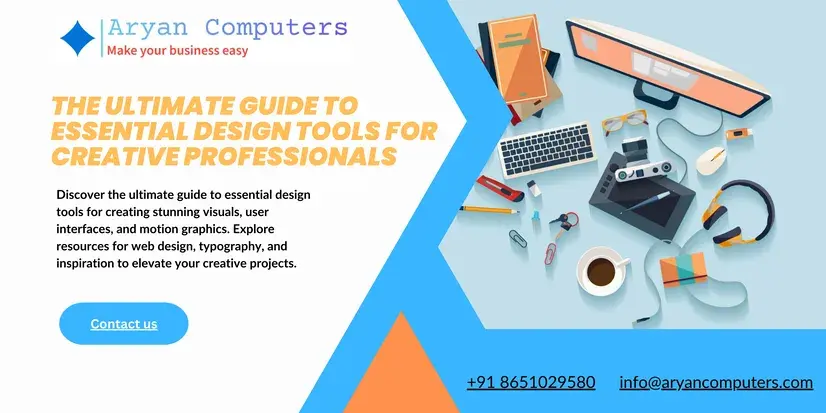In today’s digital era, design is at the forefront of creating engaging and functional visuals, interfaces, and user experiences. Whether you're a seasoned designer or just starting, understanding the right tools for the job can elevate your creative process. This comprehensive guide explores essential design tools and resources that cater to various design needs, from crafting stunning visuals to creating intuitive user interfaces and beyond.
Visual Design Tools: Crafting Stunning Graphics
Designers rely on powerful tools to transform their ideas into compelling visuals. Let’s dive into some of the most popular design software:
- Figma: A cloud-based design platform perfect for real-time collaboration, Figma allows teams to work on wireframes, prototypes, and designs simultaneously. Its cross-platform capabilities make it a favorite among UI/UX designers.
- Adobe Photoshop: The go-to software for photo editing, retouching, and complex graphic creation, Photoshop offers unparalleled control over layers, effects, and creative tools.
- Adobe Illustrator: Ideal for vector-based design, Illustrator excels in creating logos, icons, and scalable illustrations.
- Canva: An intuitive design tool for beginners and professionals alike, Canva simplifies creating social media graphics, presentations, and marketing materials with pre-designed templates.
- Sketch: A vector graphics editor tailored for UX and UI design, Sketch is widely used for prototyping and creating pixel-perfect designs.
UI/UX Design Tools: Enhancing User Experience
Designing user-centric interfaces requires specialized tools that streamline prototyping and collaboration:
- InVision: A prototyping tool that integrates seamlessly with other design platforms, InVision allows designers to create interactive prototypes and gather feedback.
- Adobe XD: Offering a robust set of tools for wireframing and prototyping, Adobe XD is perfect for creating immersive user experiences with interactive elements.
- Proto.io: This platform simplifies creating high-fidelity prototypes that closely resemble the final product. It's particularly useful for testing user interactions and flows.
Motion Graphics Tools: Adding Dynamic Elements
Motion graphics bring designs to life, making them more engaging and visually appealing:
- Blender: An open-source 3D design and animation software, Blender is perfect for creating motion graphics, visual effects, and animations.
- Adobe After Effects: A powerhouse for motion design, After Effects enables designers to create cinematic titles, transitions, and visual effects with ease.
- Lottie: This platform allows designers to create and export lightweight, scalable animations that integrate seamlessly with web and app projects.
Web Design Tools: Simplifying Development
Responsive web design is crucial in today’s mobile-first world. These tools make creating stunning, functional websites a breeze:
- Webflow: A no-code platform that merges design and development, Webflow enables designers to create responsive websites with visual editors and clean code.
- Wix: Known for its drag-and-drop simplicity, Wix is perfect for building websites quickly without needing technical expertise.
- Bootstrap Studio: This desktop application streamlines building responsive websites with ready-made components and a visual interface.
Stock Images, Icons, and Illustrations: Enhancing Visual Appeal
Finding the right visuals is essential for impactful designs. Here are some top resources:
Stock Image Platforms
- Unsplash: A platform offering high-quality, royalty-free images contributed by photographers worldwide.
- Pexels: Provides a vast collection of free images and videos for personal and commercial use.
- Shutterstock: A premium service offering millions of images, videos, and music tracks for creative projects.
Icon Libraries
- Flaticon: Offers an extensive collection of free and premium icons in various formats.
- Iconscout: Features icons, illustrations, and stock images, making it a one-stop design resource.
Free Illustration Tools
- Humaaans: A tool for customizing illustrations of people to fit your design needs.
Typography and Color Palettes: Setting the Tone
Typography and color are crucial elements that influence a design’s aesthetics and usability:
Font Resources
- Google Fonts: A free library of open-source fonts for web and print design.
- DaFont: Offers a wide variety of free fonts, from decorative to professional styles.
- Font Squirrel: A curated collection of free fonts, with a focus on quality and commercial use.
Color Palette Tools
- Coolors: A fast and easy way to generate color schemes and explore trending palettes.
- Adobe Color: Formerly known as Adobe Kuler, this tool helps you create harmonious color schemes.
- Color Hunt: A curated collection of trendy color palettes for inspiration.
Finding Inspiration: Staying Ahead in Design
Inspiration fuels creativity, and the following platforms showcase the best in design:
- Dribbble: A community for designers to showcase their work, Dribbble is a treasure trove of inspiration for all types of design.
- Behance: Adobe’s platform for creative professionals to display their portfolios and discover global design trends.
- Awwwards: Highlights the best in web design, recognizing innovative and visually stunning websites.
Conclusion
The world of design is ever-evolving, and equipping yourself with the right tools and resources is essential to stay ahead. From creating stunning visuals with Figma and Adobe Photoshop to crafting seamless user experiences with Adobe XD and Proto.io, each tool has its unique strengths. Motion graphics tools like Blender and Adobe After Effects add dynamic flair, while web design platforms like Webflow and Bootstrap Studio simplify responsive development. Complement your designs with stock images, icons, illustrations, and fonts from curated resources to create visually captivating projects.
For inspiration and staying updated on trends, platforms like Dribbble, Behance, and Awwwards are invaluable. Embrace these tools, and watch your creativity soar to new heights!

